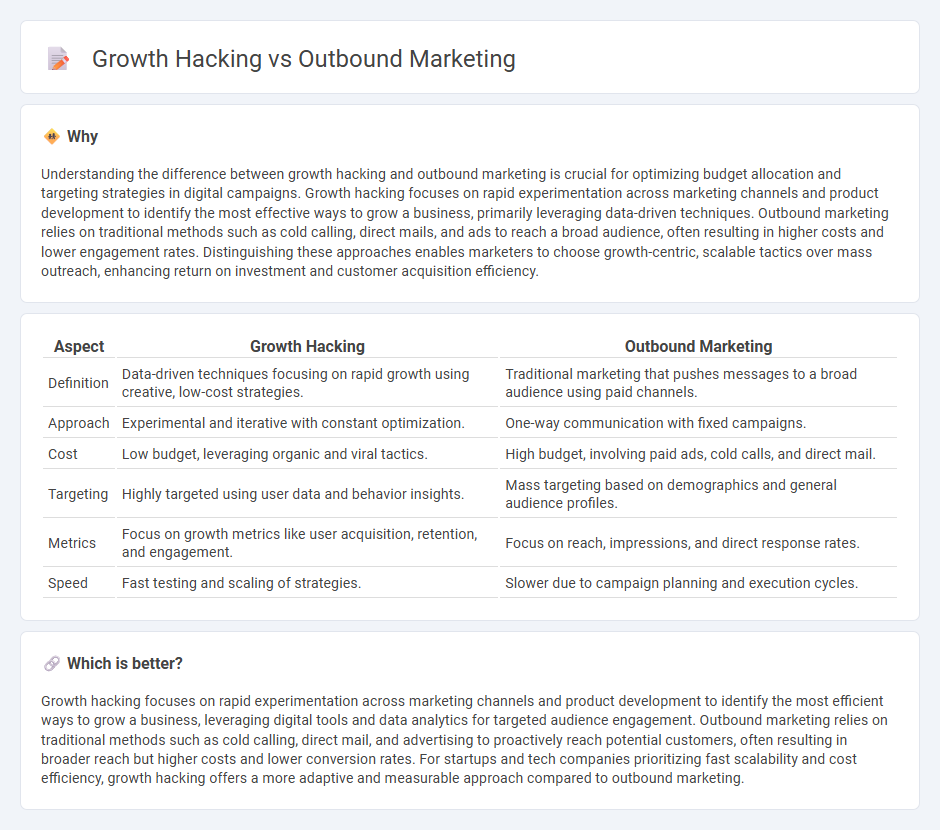
Growth hacking leverages data-driven experiments and innovative digital strategies to rapidly increase customer acquisition and brand visibility. Outbound marketing relies on traditional advertising methods like cold calling, direct mail, and TV ads to reach a broad audience and generate leads. Explore the key differences and benefits of each strategy to optimize your marketing efforts.
Why it is important
Understanding the difference between growth hacking and outbound marketing is crucial for optimizing budget allocation and targeting strategies in digital campaigns. Growth hacking focuses on rapid experimentation across marketing channels and product development to identify the most effective ways to grow a business, primarily leveraging data-driven techniques. Outbound marketing relies on traditional methods such as cold calling, direct mails, and ads to reach a broad audience, often resulting in higher costs and lower engagement rates. Distinguishing these approaches enables marketers to choose growth-centric, scalable tactics over mass outreach, enhancing return on investment and customer acquisition efficiency.
Comparison Table
| Aspect | Growth Hacking | Outbound Marketing |
|---|---|---|
| Definition | Data-driven techniques focusing on rapid growth using creative, low-cost strategies. | Traditional marketing that pushes messages to a broad audience using paid channels. |
| Approach | Experimental and iterative with constant optimization. | One-way communication with fixed campaigns. |
| Cost | Low budget, leveraging organic and viral tactics. | High budget, involving paid ads, cold calls, and direct mail. |
| Targeting | Highly targeted using user data and behavior insights. | Mass targeting based on demographics and general audience profiles. |
| Metrics | Focus on growth metrics like user acquisition, retention, and engagement. | Focus on reach, impressions, and direct response rates. |
| Speed | Fast testing and scaling of strategies. | Slower due to campaign planning and execution cycles. |
Which is better?
Growth hacking focuses on rapid experimentation across marketing channels and product development to identify the most efficient ways to grow a business, leveraging digital tools and data analytics for targeted audience engagement. Outbound marketing relies on traditional methods such as cold calling, direct mail, and advertising to proactively reach potential customers, often resulting in broader reach but higher costs and lower conversion rates. For startups and tech companies prioritizing fast scalability and cost efficiency, growth hacking offers a more adaptive and measurable approach compared to outbound marketing.
Connection
Growth hacking leverages rapid experimentation across marketing channels to identify the most effective ways to scale a business, often incorporating outbound marketing tactics such as cold emailing, targeted ads, and direct outreach. Outbound marketing serves as a crucial component within growth hacking strategies by generating immediate leads and expanding audience reach via proactive communication methods. Integrating outbound marketing campaigns with data analytics enables marketers to optimize growth hacking efforts and accelerate customer acquisition efficiently.
Key Terms
Lead Generation
Outbound marketing targets potential customers through traditional channels like cold calling, email blasts, and paid advertisements to generate leads quickly. Growth hacking emphasizes data-driven, innovative strategies such as viral content, SEO optimization, and A/B testing to attract and convert leads efficiently. Explore deeper insights to optimize your lead generation strategy effectively.
Virality
Outbound marketing relies on traditional methods like cold calls and ads to reach broad audiences, often with higher costs and lower engagement rates. Growth hacking emphasizes rapid experimentation with viral content and product features to drive exponential user acquisition and organic growth. Discover more about how leveraging virality can transform your marketing strategy.
Paid Acquisition
Outbound marketing relies heavily on paid acquisition strategies such as display ads, cold calling, and direct mail campaigns to reach a broad audience and generate leads quickly. Growth hacking emphasizes data-driven experimentation and targeted paid acquisition channels like social media ads and search engine marketing to optimize customer acquisition cost and improve conversion rates. Discover detailed insights on how paid acquisition can be leveraged effectively in both outbound marketing and growth hacking approaches.
Source and External Links
Outbound Marketing Examples To Grow Brand Awareness - Outbound marketing is a method that pushes messages to potential customers before they show interest, using tactics like cold emails, TV ads, and billboards to build audiences and close sales, focusing on relevance and connection rather than annoyance.
What Is Outbound Marketing? - Outbound marketing involves initiating contact with an audience through traditional advertising forms like TV commercials, cold calls, and print ads, contrasting with inbound marketing where customers find you, yet it remains widely used despite often being less trackable and less profitable.
Inbound Vs Outbound Marketing: What is the Difference? - Outbound marketing is effective in omnichannel strategies and for reaching non-digital native audiences via ads, catalogs, and broadcasts, with strengths in brand awareness and local targeting, while inbound marketing focuses on digital content and audience engagement.
 dowidth.com
dowidth.com